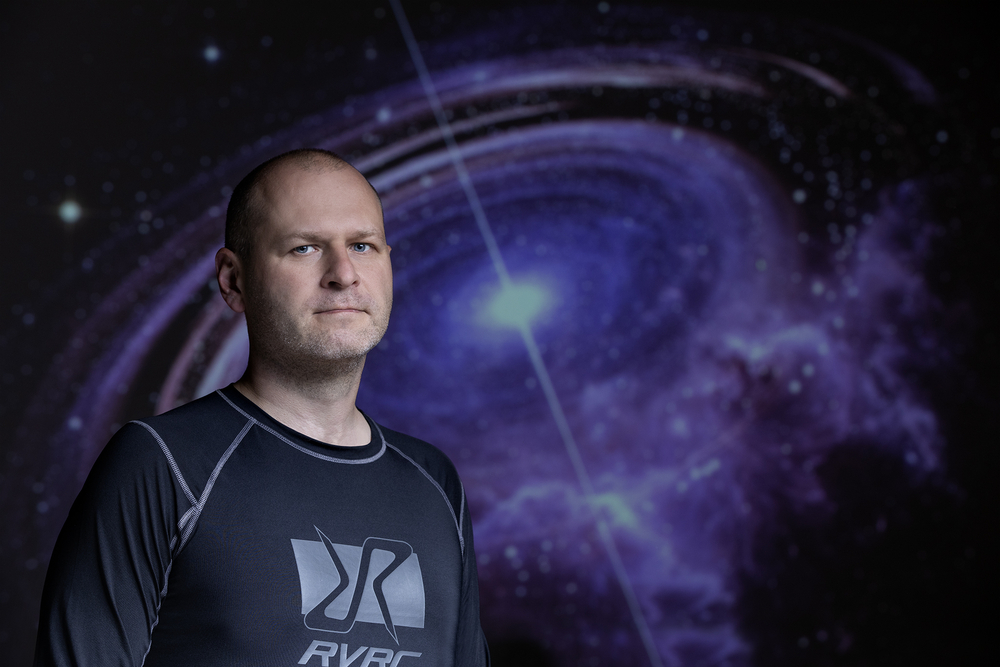
Neutron stars are quite exotic objects made, unlike black holes, only of neutron matter. They have smaller masses than black holes and they are the final stage of the evolution of stars with large masses (up to 10 solar masses). To observe them and the phenomena taking place in their immediate vicinity, specialised tools are necessary – models that describe them.
Very interesting processes occur around neutron stars, among others, the release of a huge amount of energy, which goes into the energy range corresponding to X-rays, the same as used, for example, in diagnostics. By analysing the spectrum of the radiation, it is possible to determine what is happening in these objects. And this is what our original model is for.
– explains dr Michał Szanecki (in the photo above).
Development of astrophysics and the international scope of research
A black hole, referred to as a region of space-time, has a so-called singularity inside it – there is a very large (or even infinite) gravitational field in it, which causes that nothing, not even photons (particles of light), can get out of it. Black holes are basically well understood, there are already tools for their study, so scientists have focused their attention on neutron stars, around which such formations as accretion disks (spinning structures formed by dust and gas, falling on a strong source of gravity) are also observed. They occur in binary star systems, where material falling off from the donor star falls onto a neutron star, forming around it a disc that reflects radiation.
To describe such complex configurations as neutron star systems, a strongly interdisciplinary approach is required, including quantum mechanics, quantum field theory (QFT), hydrodynamics or general relativity. One of the most important elements in the study of objects with X-ray emission is a model in which a mathematical description of physical phenomena is used.
With the enormous complexity of phenomena and processes to be taken into account in the calculations, the only effective methodology is the use of numerical calculations and simulations. Currently, for the analysis of spectra observed from accretion disks around black holes, a range of commonly available models is used. The most accurate one among them is the one created by dr Michał Żanecki, in cooperation with prof. Andrzej Niedźwiecki and prof. Andrzej Zdziarski, which takes into account the effects of general relativity.
However, for the correct analysis of X-rays released within neutron stars, a model different from that used in the case of black holes is necessary. Since neutron stars, unlike black ones, have a rigid shell, radiation can bounce not only off the accretion disk, but also from itself. Our model allows for the analysis of the X-ray spectrum emitted from the immediate vicinity of these stars – says dr Michał Szanecki. – Previous models that we have developed have already aroused interest in the international scientific community and have proved to be useful research tools.
– says dr Michał Szanecki.
A hyper-accurate model and discovering the secrets of the universe
The scientists are currently focusing on the reflection of radiation from the surface of a neutron star. This allows for a very accurate determination of the important parameters of the system, such as the speed of the star rotation, its radius, ionization, as well as the atomic composition of such a structure.
Thanks to this, we can examine whether what we believe is actually responsible for generating this radiation is what it is, or whether our direction of thinking needs modification. This will lead to the better understanding of the whole and, as a result, will bring us closer to determining the final equation of the state of neutron matter, and as a result to further discovering what is still unexplored in space.
– explains dr Michał Szanecki.
The preliminary results are promising. The researchers assume that within two years of the project financed under the internal IDUB grants, they will be able to finalise the whole and provide the world with a description and operation of the author's model for the the X-ray spectrum analysis.
IDUB grants of the University of Lodz
The UL Excellence Initiative - Research University – grant competitions under which the University of Lodz funds research ideas of its scientists and doctoral students. By supporting them in conducting high quality research, the university implements a strategy of striving for research excellence in all fields and disciplines. The competitions also serve the purpose of internationalisation – developing and strengthening the University's cooperation with international researchers. As part of grants addressed to scientists from outside the University, experienced and young researchers join the team of the University of Lodz. This favours the fusion of experiences and increasing the University's scientific potential, supports networking and employee mobility. .
The grants are financed as part of the subsidy increased by 2% for universities that joined the IDUB competition in 2019. University of Lodz will receive additional funding for research until 2026. Internal grant competitions have been implemented since 2020.
Currently, in the 2nd edition, over PLN 3 million was used to finance young, experienced researchers and doctoral students in such grant competitions as: UL IDUB "Grants for young and experienced researchers" and "Doctoral research grants".
Source: dr Michał Szanecki, Faculty of Physics and Applied Informatics, University of Lodz
Edit: Promotion Centre of the University of Lodz
Photo: Bartosz Kałużny, Promotion Centre of the University of Lodz
